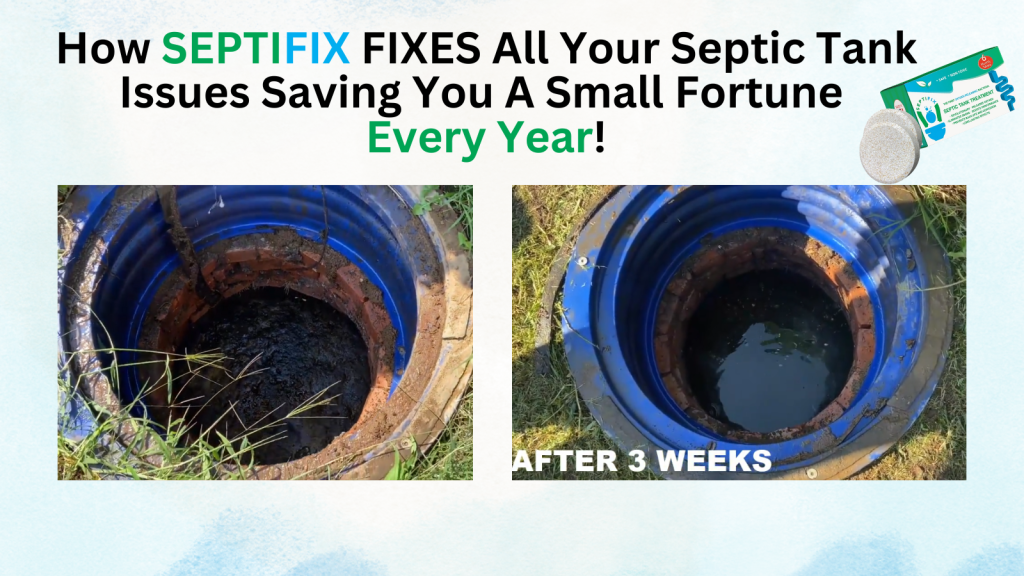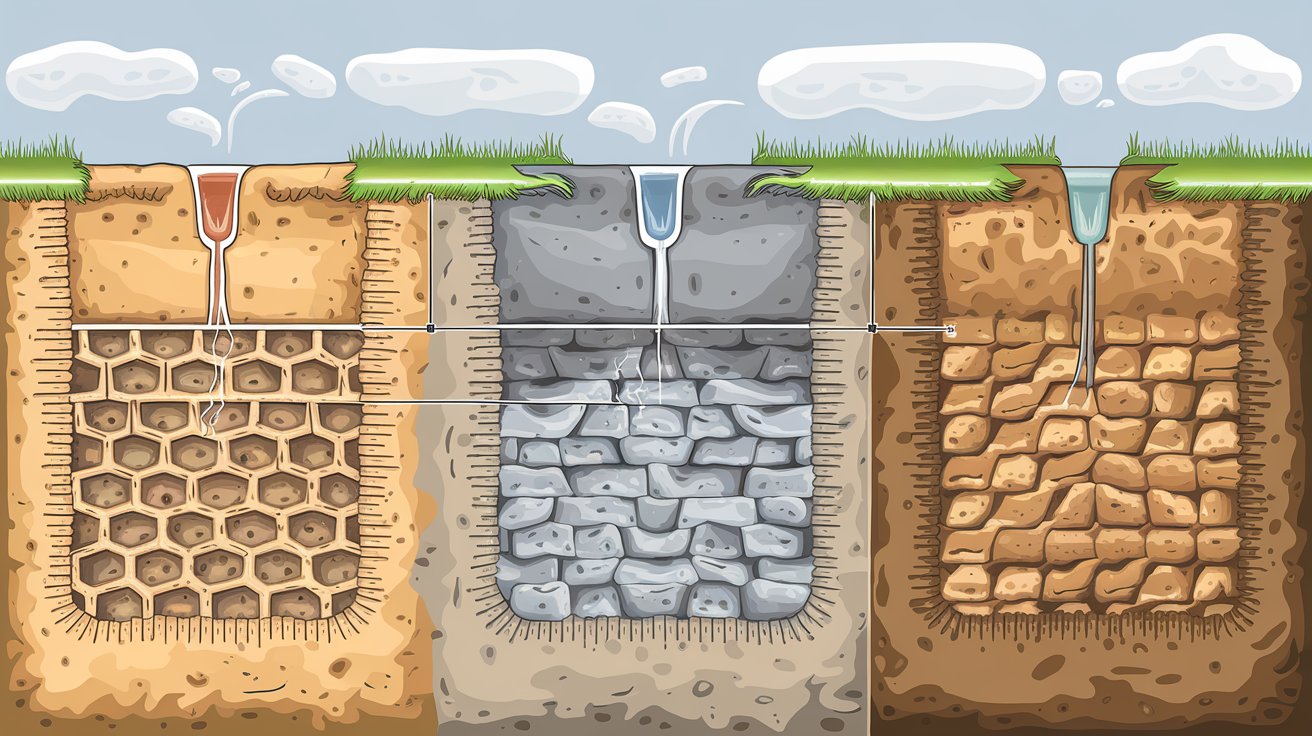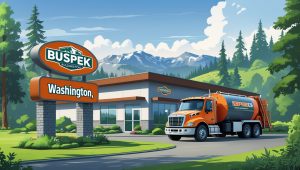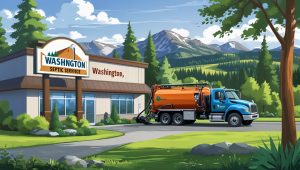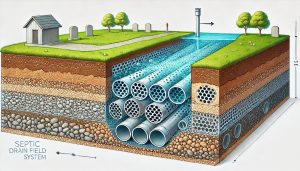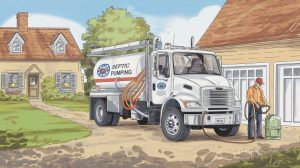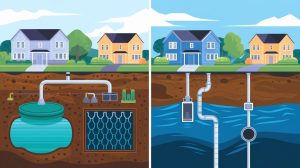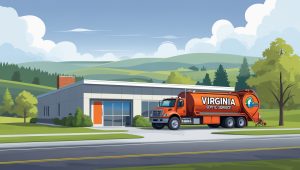When it comes to septic systems, many homeowners focus on the tank—but the real work happens underground in the drain field. One of the most important factors in drain field performance is soil type. If you’ve ever wondered, how does soil type affect a drain field?, you’re not alone. The soil beneath your yard doesn’t just absorb water—it helps treat wastewater. Choosing the wrong soil or installing a system in unsuitable conditions can lead to backups, flooding, and costly repairs.
Understanding your soil type isn’t just for gardeners—it’s essential for septic system health, especially in areas where onsite wastewater treatment (like leach fields or percolation beds) is the only option.
Table of Contents
- Why Soil Type Matters in Septic Drain Fields
- Common Soil Types and Their Impact on Drain Fields
- Soil Testing Before Installation
- How Soil Conditions Can Change Over Time
- Soil Solutions for Problem Drain Fields
- Contact Info and Resources
- Septic Permit Links by State
Why Soil Type Matters in Septic Drain Fields
Soil’s Role in Wastewater Treatment
A septic drain field (also called a leach field or soil absorption area) relies on natural processes to filter wastewater. After waste exits the septic tank, it enters perforated pipes in the drain field, where it slowly seeps into the surrounding soil. Here, microbes break down contaminants before the water reaches the groundwater table.
But this natural filtration only works if the soil type is right.
Key Functions of the Soil
- Absorption: The soil must take in water at a steady, reliable rate.
- Filtration: Soil particles and microbial life help remove harmful bacteria and pathogens.
- Evaporation: Some water evaporates through the soil’s surface.
- Percolation: Treated water slowly moves downward through soil layers.
Common Soil Types and Their Impact on Drain Fields
1. Sandy Soil: Great Drainage, Less Filtration
Sandy soil is loose, gritty, and drains quickly. While this is great for preventing standing water, it can allow wastewater to pass through too fast, without enough time for proper treatment.
Pros:
- Excellent drainage
- Low risk of waterlogging
Cons:
- Poor filtering ability
- Higher risk of groundwater contamination
Pro Tip: Sandy soils often require enhanced treatment systems or added filtration barriers.
2. Clay Soil: Poor Drainage, High Compaction
Clay soils are dense, sticky when wet, and slow to drain. These soils hold onto water, which can quickly lead to system overload, soggy yards, and even sewage backups.
Pros:
- Good filtering properties
- Strong microbial activity
Cons:
- Very slow percolation rate
- High risk of system failure from water saturation
Real-World Insight: In areas with heavy clay, systems often need a raised bed septic system or engineered alternatives.
3. Loamy Soil: The Goldilocks Option
Loam is a balanced mix of sand, silt, and clay. It provides excellent drainage while still allowing time for filtration. This makes it ideal for most drain field installations.
Pros:
- Ideal absorption rate
- Good balance of drainage and filtration
- Supports healthy microbial ecosystems
Cons:
- May still need testing to confirm suitability
4. Silty Soil: Moderate Drainage, Compaction Risks
Silt is smooth and feels floury. It retains water better than sand but doesn’t drain as poorly as clay. However, it can compact over time, reducing its effectiveness.
Pros:
- Decent filtration
- Moderate absorption
Cons:
- Can become compacted
- Risk of reduced percolation over time
Soil Testing Before Installation
Before any septic system is installed, a percolation test (or “perc test”) is required. This test measures how quickly water drains through the soil and helps determine the best type of system for the property.
What a Perc Test Reveals:
- Drainage rate (too fast or too slow can cause issues)
- Soil composition
- Depth to groundwater or bedrock
Important Tip: Always have this test done by a certified septic designer or engineer—some local health departments require it for permitting.
How Soil Conditions Can Change Over Time
Even if your drain field worked great 10 years ago, soil conditions can shift. Heavy machinery, flooding, landscaping changes, or even the natural breakdown of organic matter can affect the percolation rate and drainage capacity.
Signs Your Soil Is No Longer Supporting the Drain Field:
- Standing water or soggy patches
- Slow drains in the home
- Foul odors near the drain field
- Frequent need for pumping
Soil Solutions for Problem Drain Fields
1. Soil Replacement or Amendments
In some cases, you can improve drainage by mixing sand into clay-heavy soil or adding organic matter to compacted silt.
2. Installing an Alternative System
If the soil just isn’t working, alternative septic systems like mound systems or aerobic treatment units (ATUs) can be more effective in challenging soils.
3. Drain Field Relocation
Sometimes, the best option is to install a new drain field in a different area of the property with better soil characteristics.
Contact Info and Resources
If you’re unsure about your soil type or whether your drain field is performing correctly, it’s best to reach out to a local septic professional. Use these resources for guidance:
- EPA SepticSmart Program – Tips for septic system maintenance and soil considerations
- USDA Soil Survey – Find soil maps and data for your property
- Your local county health department – For perc test requirements and system approval
Need help finding a septic specialist? Check out local directories or county-approved installers to evaluate your system.
Conclusion
So, how does soil type affect a drain field? The answer is: in just about every way. From drainage speed to filtering ability, the soil beneath your septic system directly influences how well it treats wastewater and how long it lasts. Understanding your soil type—and designing your system accordingly—can mean the difference between smooth operation and expensive headaches.
Take action today: Test your soil, inspect your system, and talk to a local expert before small issues turn into big problems.
